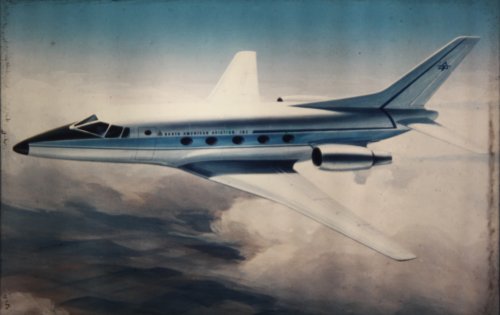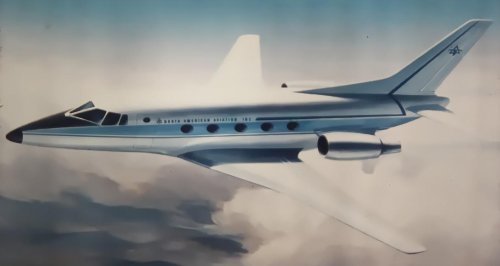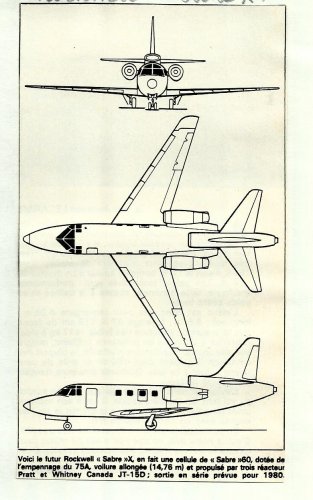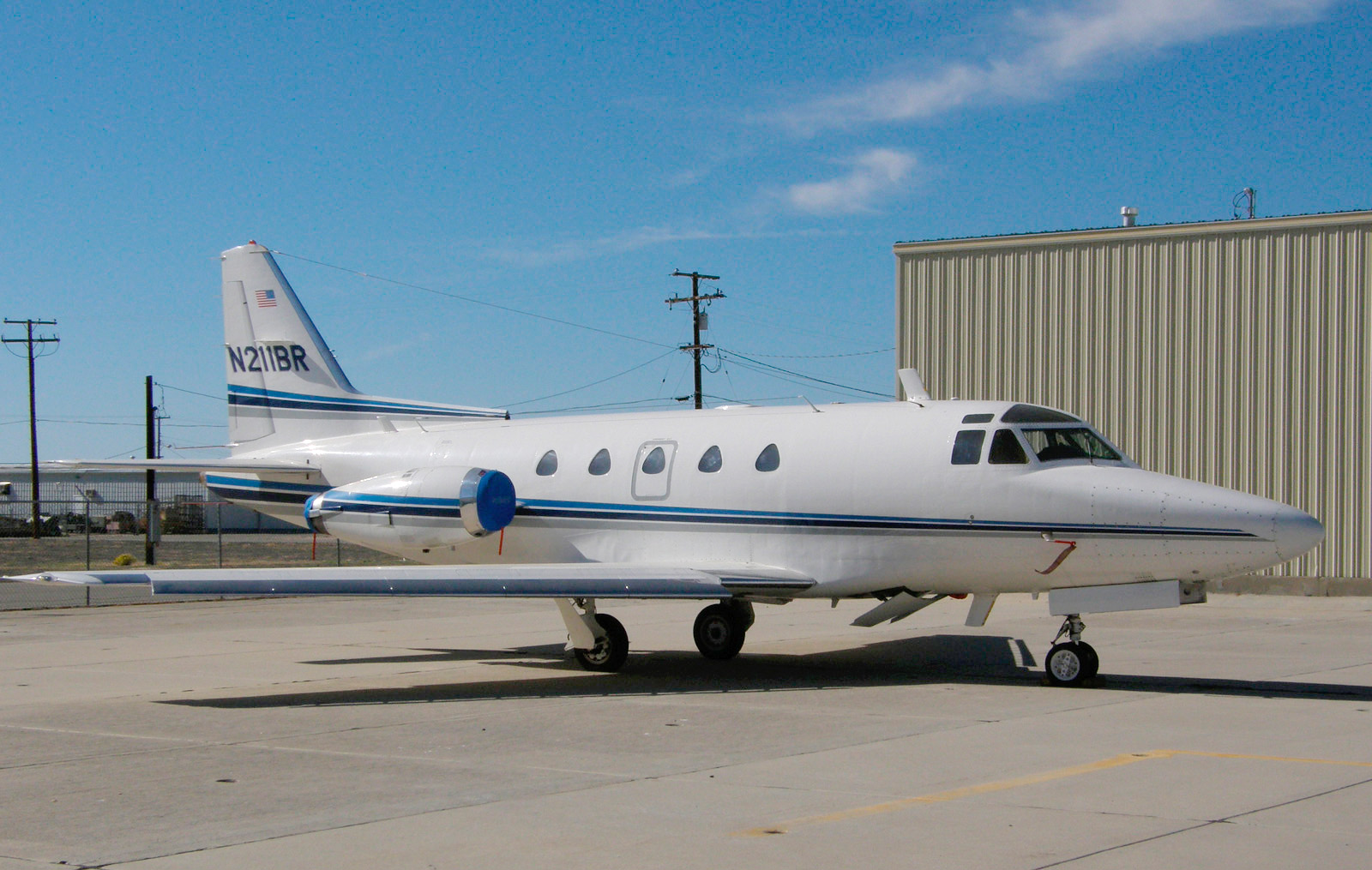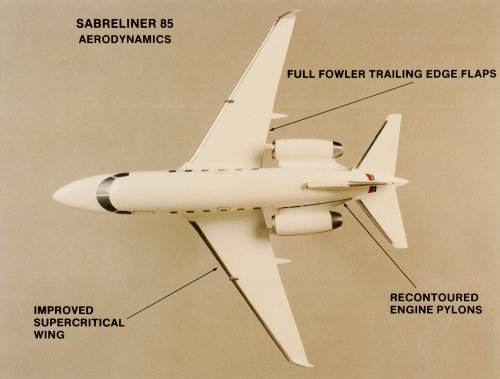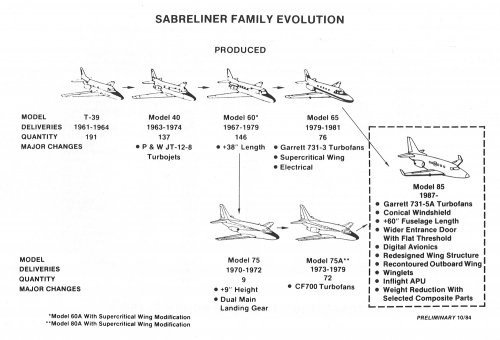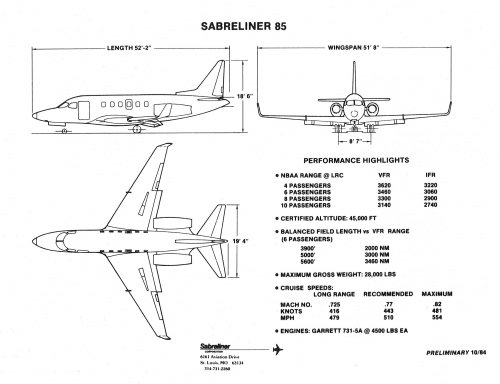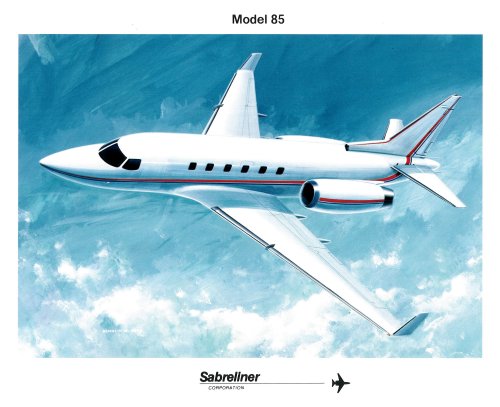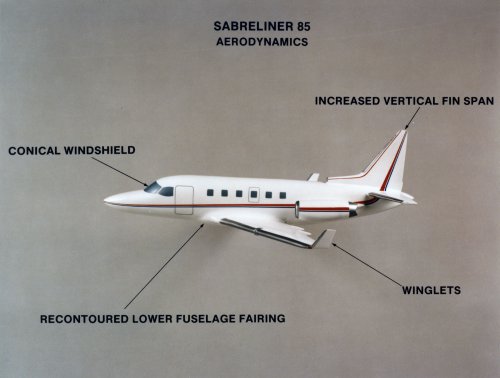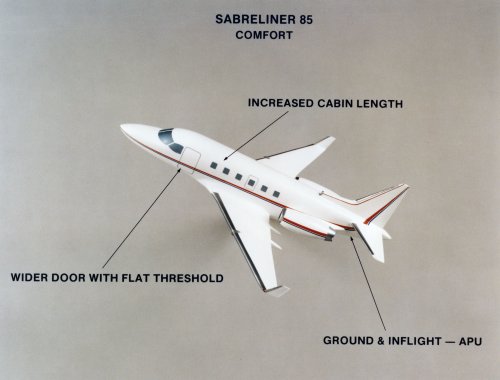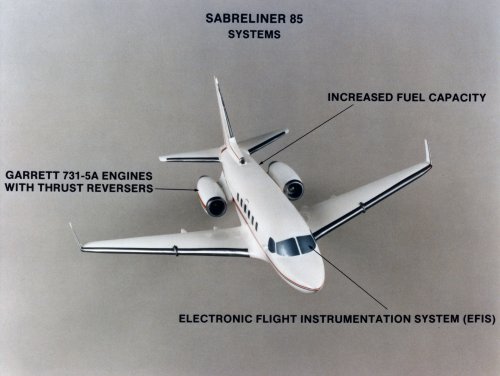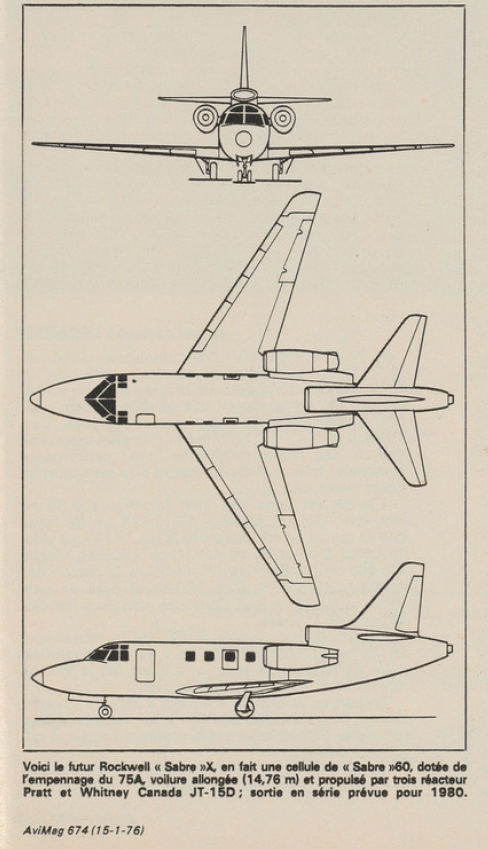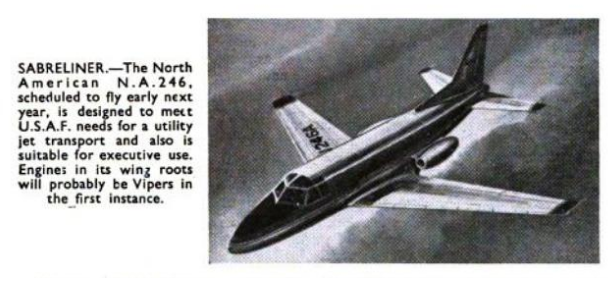I found this quote in another topic: "What about the disgraceful O-47? The inelegant Sabreliner?" Perhaps as a answer to the second part of that question I will present the following image and also ask if this is the NA-465, "Sabreliner 65", that hesham mentioned more than seven years ago? Other than the image I have no further information about it.
You are using an out of date browser. It may not display this or other websites correctly.
You should upgrade or use an alternative browser.
You should upgrade or use an alternative browser.
Ultimate Sabreliner
- Thread starter JimK
- Start date
Jos Heyman
ACCESS: Top Secret
- Joined
- 15 February 2007
- Messages
- 597
- Reaction score
- 57
I think whoever wrote the quote is a bit mixed up - but it is of course too difficult to assess that without reading the context in which the quote was made.
The aircraft designated by the USAAF as O-47 was originally developed by General Aviation (as GA-15) in 1935. General Aviation became part of North American.
The name Sabre was not introduced until the late 1940s with the introduction of the P-86 (later F-86). Obviously what we now know as Sabreliner derived its name from the F-86.
So whilst the O-47 was certainly an ugly looking aircraft (in my opinion) the link to 'Sabreline' is somewhat of a nonsense, unless, as I suggested above, we see the statement in its full context and not as a quote.
Anyway, that's my Aussie dollar's worth.
The aircraft designated by the USAAF as O-47 was originally developed by General Aviation (as GA-15) in 1935. General Aviation became part of North American.
The name Sabre was not introduced until the late 1940s with the introduction of the P-86 (later F-86). Obviously what we now know as Sabreliner derived its name from the F-86.
So whilst the O-47 was certainly an ugly looking aircraft (in my opinion) the link to 'Sabreline' is somewhat of a nonsense, unless, as I suggested above, we see the statement in its full context and not as a quote.
Anyway, that's my Aussie dollar's worth.
- Joined
- 27 December 2005
- Messages
- 16,505
- Reaction score
- 19,323
- Joined
- 13 June 2007
- Messages
- 2,031
- Reaction score
- 2,262
Indeed quite an attractive aircraft. Interesting V shape to the center windshield.
Thanks for sharing this! Mark
Thanks for sharing this! Mark
- Joined
- 25 June 2009
- Messages
- 13,795
- Reaction score
- 3,124
Jos Heyman said:I think whoever wrote the quote is a bit mixed up - but it is of course too difficult to assess that without reading the context in which the quote was made.
The aircraft designated by the USAAF as O-47 was originally developed by General Aviation (as GA-15) in 1935. General Aviation became part of North American.
The name Sabre was not introduced until the late 1940s with the introduction of the P-86 (later F-86). Obviously what we now know as Sabreliner derived its name from the F-86.
So whilst the O-47 was certainly an ugly looking aircraft (in my opinion) the link to 'Sabreline' is somewhat of a nonsense, unless, as I suggested above, we see the statement in its full context and not as a quote.
Anyway, that's my Aussie dollar's worth.
Quote was mine. Someone said that North American had only produced beautiful designs, and so my answer was that.
Of course this much improved design has very little left of the original Sabreliner, it looks a lot better.
- Joined
- 27 December 2005
- Messages
- 16,505
- Reaction score
- 19,323
- Joined
- 31 May 2009
- Messages
- 1,156
- Reaction score
- 514
Thank you Paul, for that nice photo of a North American Sabreliner. As one of the very first business jets, I feel it is not only a beautiful aircraft, but also more functional than its only competitor at the time, the Lockheed JetStar. In fact, Robert Six, founder of Continental Airlines, canceled his order for JetStars when he discovered he could not stand upright in the cabin. The extra inches of the Sabreliner ceiling height would pay off time and again, as would its wing, directly derived from that of the F-86.
I remember a compelling promotional photograph by NAA's PR department, showing the F-86 and the Sabreliner side-by-side, with their identical wings. This was a compelling sales tool back in the day, given the crushing kill ratio of the F-86 over the MiG-15 during the Korean War.
I remember a compelling promotional photograph by NAA's PR department, showing the F-86 and the Sabreliner side-by-side, with their identical wings. This was a compelling sales tool back in the day, given the crushing kill ratio of the F-86 over the MiG-15 during the Korean War.
Hmmmm, I note the Sabreliner in the artwork has circular windows reminiscent of a Gulfstream. In reality, Sabreliners were famous for their tri-angular windows, although some later models had retangular.
The NA-465 Sabreliner was actually built and is not the aircraft in the artwork above. Any clues as to the purported model? I think I remember that a stretched model 80/85 was planned at one time.
C
The NA-465 Sabreliner was actually built and is not the aircraft in the artwork above. Any clues as to the purported model? I think I remember that a stretched model 80/85 was planned at one time.
C
- Joined
- 31 May 2009
- Messages
- 1,156
- Reaction score
- 514
thebig C said:Hmmmm, I note the Sabreliner in the artwork has circular windows reminiscent of a Gulfstream. In reality, Sabreliners were famous for their triangular windows, although some later models had rectangular.
The combination of twin rear-mounted engines and triangular windows caused a hissy-fit at Sud Aviation, who felt the Sabreliner "looked" too much like a small Caravelle. I believe this was around the time Douglas was involved with the program. A complaint ensued, but I can't remember what was decided. Perhaps triangular windows were avoided on later variants, to keep the lawyers happy.
Indeed, I believe it was the later 1970s produced versions that featured the square windows (which probably also had the practical purpose of making the cabin alot brighter).
Its funny that you should mention other manufacturers eyeing up the sabreliner for possible copyright infringement as in the artwork above one is struck by the fact that this aircraft looks like a beautiful amalgam of several Bizjets. As I've already mentioned the circular windows are decidedly Gulfstream-esque but also the nose (unusual windscreen aside) has a rakish streamlined quality to it deeply reminiscent of contemporary Dassault designs and a far cry from the distinct "nose" of a Sabreliner.
C
Its funny that you should mention other manufacturers eyeing up the sabreliner for possible copyright infringement as in the artwork above one is struck by the fact that this aircraft looks like a beautiful amalgam of several Bizjets. As I've already mentioned the circular windows are decidedly Gulfstream-esque but also the nose (unusual windscreen aside) has a rakish streamlined quality to it deeply reminiscent of contemporary Dassault designs and a far cry from the distinct "nose" of a Sabreliner.
C
MaxLegroom
Why not?
- Joined
- 28 December 2013
- Messages
- 158
- Reaction score
- 45
I was about to add that the triangular center window seemed NAC 60 derived...
- Joined
- 13 June 2007
- Messages
- 2,031
- Reaction score
- 2,262
Good Day All!
Though likely not the Ultimate Sabreliner in terms of artwork, the Sabreliner Model 85 was funded for initial engineering design. When Sabreliner bought the Sabreliner line from North American and moved production to St. Louis, MO and later to Perryville, MO, the project continued to be funded for about a year before being dropped.
Last week I spent a productive day with Sabreliner's retired production manager who loaned me a number of documents and photos related to the Sabreliner programs and one of the items was a Model 85 proposal document to be shared with prospective customers. Attached are some of the pages - I have a few more to rescan as the brown background of the model scans poorly on the printer/scanner at work. In the meantime, a few goodies to whet your appetite!
Enjoy the Day! Mark
Though likely not the Ultimate Sabreliner in terms of artwork, the Sabreliner Model 85 was funded for initial engineering design. When Sabreliner bought the Sabreliner line from North American and moved production to St. Louis, MO and later to Perryville, MO, the project continued to be funded for about a year before being dropped.
Last week I spent a productive day with Sabreliner's retired production manager who loaned me a number of documents and photos related to the Sabreliner programs and one of the items was a Model 85 proposal document to be shared with prospective customers. Attached are some of the pages - I have a few more to rescan as the brown background of the model scans poorly on the printer/scanner at work. In the meantime, a few goodies to whet your appetite!
Enjoy the Day! Mark
Attachments
- Joined
- 13 June 2007
- Messages
- 2,031
- Reaction score
- 2,262
- Joined
- 8 January 2006
- Messages
- 1,605
- Reaction score
- 682
If you look closely at this picture, the engines appear to be ATF3 engines rather than TFE731's. This ties in with my post, above, from 2016.Quite attractive...
I remember a compelling promotional photograph by NAA's PR department, showing the F-86 and the Sabreliner side-by-side, with their identical wings. This was a compelling sales tool back in the day, given the crushing kill ratio of the F-86 over the MiG-15 during the Korean War.
Now that's pretty awesome, never realized NAA had "recycled" an F-86 wing for their bizjet.
Where it gets really interesting is that Dassault did the exact same thing with the Falcon 20 (Mystère IV wing) and of course Learjet with the FFA P.16.
Three bizjets, three fighter wings.
- Joined
- 11 March 2012
- Messages
- 3,016
- Reaction score
- 2,702
I remember a compelling promotional photograph by NAA's PR department, showing the F-86 and the Sabreliner side-by-side, with their identical wings. This was a compelling sales tool back in the day, given the crushing kill ratio of the F-86 over the MiG-15 during the Korean War.
Now that's pretty awesome, never realized NAA had "recycled" an F-86 wing for their bizjet.
Where it gets really interesting is that Dassault did the exact same thing with the Falcon 20 (Mystère IV wing) and of course Learjet with the FFA P.16.
Three bizjets, three fighter wings.
How many F-86 parts were used in production Sabreliners?
Similar threads
-
Rockwell SSBJ Aircraft of 1981 (MMIPS)
- Started by hesham
- Replies: 23
-
Tanker Transport Training System (TTTS) USAF competition
- Started by Stargazer
- Replies: 0
-
NA/Rockwell 70's Stealth: Flying Banana, Silent Attack & Surprise Fighter
- Started by overscan (PaulMM)
- Replies: 50
-
North American Rockwell NA-335 fighter project (to USAF FX requirement)
- Started by Dronte
- Replies: 136
-

